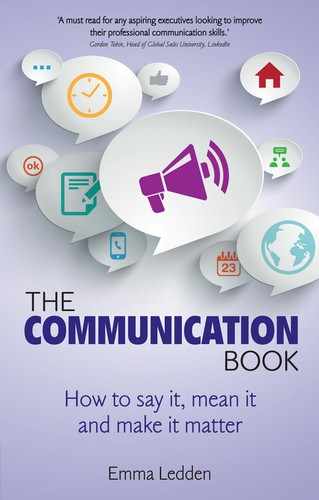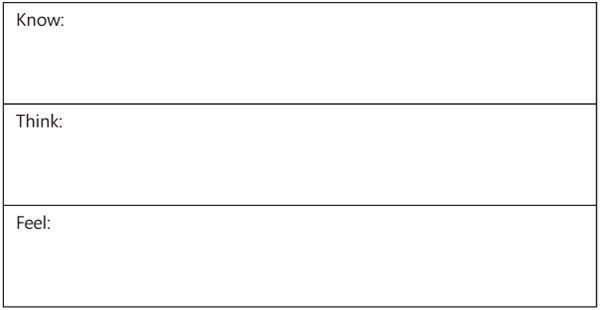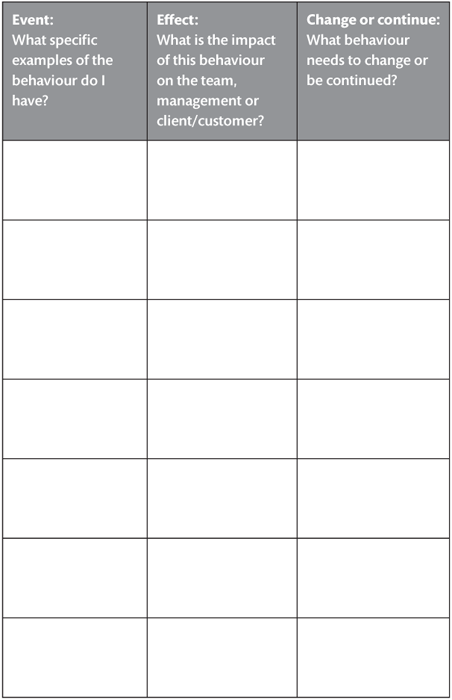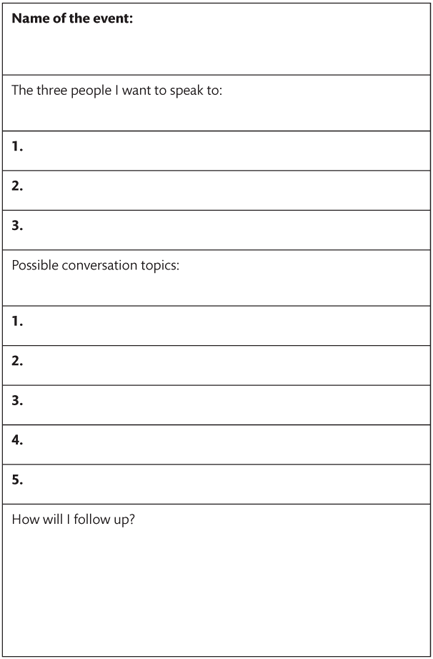
Ninety per cent of the success of your verbal communication is determined before you speak.

In order to succeed at one-to-one conversations, giving feedback, job interviews, networking, facilitation and media, there are three steps you must take before you speak.

In each chapter so far, and in the final two chapters in Section 3, we are exploring the concepts around this approach.
What I would like to do now is turn these concepts into something concrete that you can use to succeed in your interactions.
This three-step approach I am offering must be done in sequence. You must have absolute clarity about the purpose of the communication first. Once you know or decide this then you must profile your audience and understand them. Finally, armed with your intention and listener-insight, you will prepare what to say and how to say it to ensure your goal is reached.
Over the next few pages I am going to give you some simple templates that can be used to help you prepare your communication for each of the business scenarios in this book.
STEP 1
Know the purpose
In order to prepare great verbal communication you need a communication goal. You also need to know how you are going to reach your goal.
For example:



Before you engage in any of the business scenarios explored in this book, the first step in preparing is to ask yourself these three questions:
- What is the purpose of this communication/interaction?
- How do I bring my listener to that end-goal?
- Is it possible to get that outcome in this one exchange?
Is it possible in this one exchange?
Once you are clear on your purpose, you must ask yourself if it is possible to achieve it in just one exchange. Sometimes it takes many meetings and interactions to actually reach your purpose, and this first one is just a stepping-stone on the path to that point.
For example, your overall networking goal may be to get new business; however, you may have several meetings where the purpose is to build a relationship, understand the potential client’s business or simply swap ideas.
Every single interaction is different and will have a different purpose. It is vital you are clear what the communication purpose is before you can prepare what to say.
I want you to like me
For many people, their communication purpose is to be liked, admired or recognised in some way. Very often this is their only goal when they speak.
Of course you want to be liked and thought highly of. I want this for you too. However, this can’t be your only purpose as it is too self-serving. Remember, people engage and connect with you because there is something in it for them. The more you focus on your listener and on giving them something of value when you speak, the more they will think you are great.
The personal purpose for your communication is always one of being well-liked and respected, and that is OK.
For example: ‘I want the interviewer to like me and think I am smart’.
However, you must make sure you have a purposeful purpose and not just a personal purpose. (Try saying that really fast!)
A purposeful purpose is:
‘I will make sure the interviewer has all the information about me they need to make the decision to give me the job. While giving that information I will do my best to do it in a way that shows my passion, credibility and knowledge in the hope they like me and think I am smart.’
Below is a template to help you get clarity on the purpose of your communication and how it can be achieved.
This template can be applied to every business scenario in this book.
This is step one of your preparation.
Step 1: know the purpose template
What is the purpose of my communication/interaction today?

What information does the listener need in order to achieve that purpose?

Is it possible to give all the information and reach the purpose in this one exchange?

STEP 2
Understand the listener
If you don’t mind, I would like at this point to tell you a little bit about me. My name is Emma Ledden and, according to the Myers-Briggs Type Indicator® assessment, I am an ESTJ (extraversion, sensing, thinking, judgement). My social style is a ‘driver’ and I am an ‘activist’ in my learning style. Based on these labels, I am an externally-focused and enthusiastic person. I don’t like waiting, indirectness or indecisiveness. I am apparently principled, independent and intellectually creative.
On any given day I can be tired, stressed, interested or inspired. If you meet me just before lunchtime, I am probably hungry and it’s best not to speak to me. I am neither inviting nor charming while in need of food. One day I may be standing in front of you smiling, hiding a broken heart. On another day, on another week, I might be in such a good place in my life I forget pain exists, for me or for you.
And on a bad day, if you disregard me in any way, even by accident, the most insecure and vulnerable part of me is triggered and you will no longer be dealing with a grown adult, instead you will have a seven-year-old in front of you, emotionally at least.
Why am I telling you all this? Because we are all the same. I am you and you are me.
We are all human, we are all emotional and we are interacting and communicating with each other every day.
The people you are talking to in your everyday exchanges are human beings, and you need to remember and prepare for this before you speak.
You need to consider what your listener knows, thinks and feels about your information before you speak. You need to prepare for your listener’s reactions, questions and feedback to your communication. You need to do all this before you speak.
In the future, before you speak you must understand your listener by clarifying:
- What does my listener think, know and feel before I talk?
- What do I want them to think, know and feel after I talk?
Talking to different people with different needs
Talking to one person with one set of needs and emotions is a challenge, so talking to a group with possibly many different needs can feel overwhelming.
When faced with an audience, rather than just one person, the default can be to give an outpouring of general information not tailored at anyone in the hope of it satisfying everyone. This rarely works and leaves both the speaker and listeners unfulfilled.
It is hard to cater to a mixed group of listeners, and although they can’t all be talked to at once, their needs can be addressed one by one during your communication in a way that gives them something of value.
If you have a mixed group of listeners you must understand what the needs are within the group and you must decide if you are going to address all of these needs as part of the purpose of the communication. The choice is yours, based on what you want to achieve and your communication purpose.
Timing is everything
They say in life timing is everything. I am sure you have had moments in your life, both successful and disastrous, that have had some element of timing attached to them.
An important part of understanding your listener is asking the question of yourself – is this the right time to have this conversation or exchange?
I don’t mean for the timing element to be a tool for procrastination or refusal to have a conversation that needs to happen. But, before you speak just consider: is this the right moment of the day, day of the week or week of the month to speak? Are you ready, emotionally and mentally, to speak and are they ready to listen (within reason)?
In business you must have the conversation, but just make sure you pick the best possible time to have it.
Below is a simple template to help you understand your listener.
This template can be applied to every business scenario in this book.
This is step two of your preparation.
STEP 3
Prepare to speak
This book explores six business scenarios.

On the pages that follow are templates to help you prepare what to say in each individual scenario.
You must complete step one and step two, as explained, and then, depending on the interaction, choose the relevant template and fill it out in full before you speak.
This is step three in your preparation.
Step 3: prepare to speak – one-to-one communication template
What is the opening hook for this communication that tells my listener why they should listen?

What are my three key points or areas I wish to explain and talk about in this interaction?
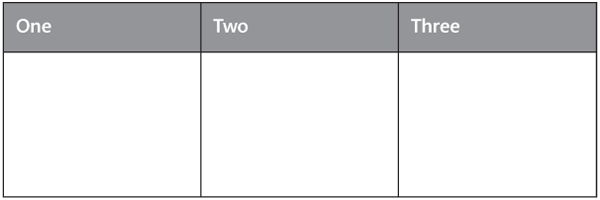
What is my concluding, take-away point or action I wish to leave the listener with?

